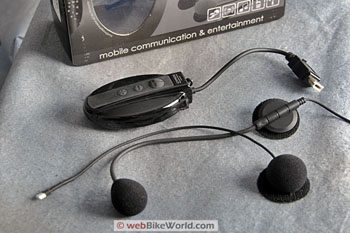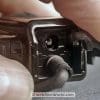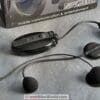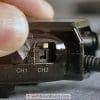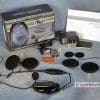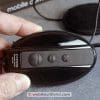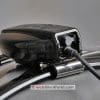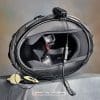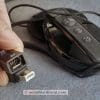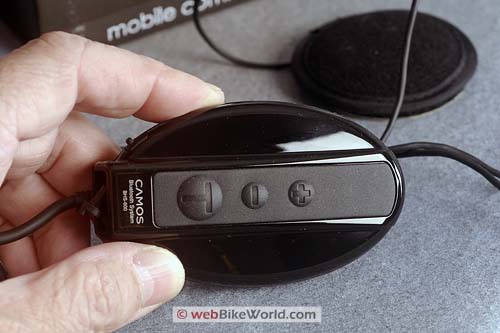Where’s the marketing department when you need it?
And with a name like “IMC Camos BHS-600”, they need it.
The IMC Camos BHS-600 Bluetooth Intercom is the most recent beneficiary of evolution in motorcycle Bluetooth intercom systems, using the latest Bluetooth 2.0 standards, and in stereo, no less.
Both of us are about as far from Double-E level knowledge as can be, but some quick research told us that Bluetooth 2.0 provides up to 2.1 Megabits per second transmission speeds, (about 3 to 10 times faster than version 1.0), along with reduced power consumption and the ability to connect with more than one Bluetooth device simultaneously.
That last point is important — remember in our review of the Interphone Bluetooth intercom that the system can connect with one or the other but not both at the same time.
“We don’t know nothin’ ’bout two-oh Bluetooth”, to paraphrase Butterfly McQueen, but what this all means with regards to the IMC Camos Bluetooth intercom is that it has two speakers and it works in stereo to provide more volume and clearer sound, in — you guessed it — stereo!
We had no idea there was such a thing…
More is better when it comes to motorcycle Bluetooth intercom sound quality and volume, no doubt about it. It’s easy to sit in the living room “Oooohing” and “Ahhhhing” over the new system, but get out on the highway with wind in the helmet and the big L-twin booming underneath and it’s a completely different story. The IMC Camos system seems to have loudness to spare, and that’s a good thing.
In addition to the two speakers (vs. the single speaker in the Interphone system), which are about 6 mm (1/4″) thin and can be easily located in just about any motorcycle helmet, the IMC Camos system comes with two different microphones, a boom mike and a wired mike.
And you get plenty of wire (see photo below); probably enough to rig up like a size 10XL helmet, if there was such a thing. But more is better when it comes to wire also; extra can always be stuffed between the liner and the shell.
Apparently, the reduced power requirements of Bluetooth 2.0 means more life for the IMC Camos battery; the company claims 10 hours talk time and 150 hours standby time.
Battery life has been one of the biggest complaints of Interphone Bluetooth users, but let’s face it — the number of riders who really need more than a couple hours of talk time surely is limited. If you need to flap your jaws for 8 hours straight, start chugging Mountain Dew and get yourself a wired system.
In any event, we’re not even sure how long the IMC Camos batteries will last, because we charged them once when they were new, taking almost exactly the 2 hours claimed in the owner’s manual, and they’ve been running ever since.
We haven’t put a clock on them but we’ve covered about a zillion miles over many rides during our evaluations, in addition to all the bench work and the things are still going strong. Since Bluetooth intercom battery life seems to vary greatly by owner, we’ll leave it up to IMC Camos owners to report back on their experiences, which we’ll post in the Owner Comments section below.
The IMC Camos Bluetooth intercom is available in a two different flavors; a BHS-500 single-channel system that, apparently, pairs only with a Bluetooth-capable cell phone selling for about $150.00 and the BHS-600 shown here, which is a true duplex intercom system, selling for about $200.00 each. And don’t forget, you’ll need two to tango, which means a total of four C’s.
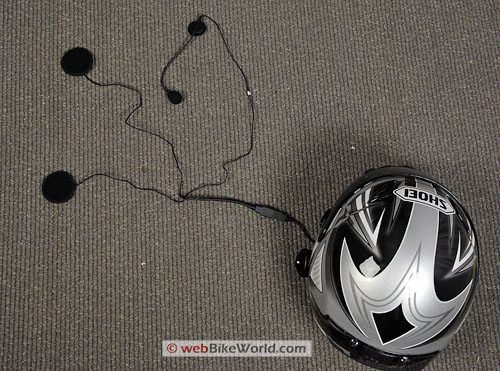
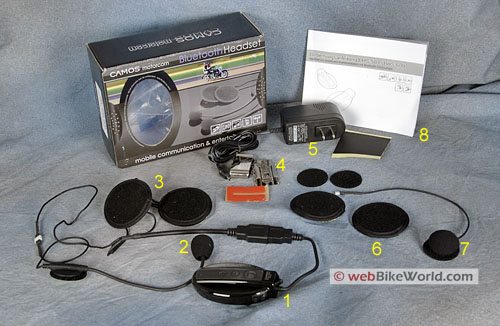
In the Kit
OK, so what does it do? Don’t count on the owner’s manual — one of the worst features of this kit, in our opinion. Why can’t these Bluetooth dudes write some instructions that make sense?
If we hadn’t cut our teeth setting up the Scala TeamSet and the Interphone Bluetooth intercomsystems, we’d probably still be fussing with this thing. Those who are not at least somewhat comfortable with computer messing-aroundishness may want to break out the yoga mat for a session before trying to figure this out.
The book doesn’t explain, for example, why there are two channels and how they work together or why. It took us some time to discover how to make the system do what it’s supposed to; i.e.,
- Works as an intercom;
- Connects with a Bluetooth-capable cell phone;
- Connects with a Bluetooth-capable GPS system;
- Connects with a Bluetooth-capable FRS-type radio and
- Apparently connects with a Bluetooth-capable cell phone on channel 2 (and we have no idea what this means or why you’d want to do it).
UPDATE: We received a detailed note on pairing and using the IMC Camos intercoms from Benchmark Helmets, a U.S.A. distributor (see summary table below).
They wrote:
“It is important to understand how the two channels work on the Camos 600. Channel 1 is represented by the “–” (red led) key and channel 2 is represented by the “+” (green led) key.
The “–” and “+” keys power the channels they represent on and off. Channel 1 is the channel you can pair up to two stereo devices on. Channel 2 is the channel reserved for the helmet to helmet intercom and can be used for a third device if you do not wish use the intercom.
The channel that you leave the “dip-switch” on is the channel that will go into “pairing-mode” if the channel is on. For example, if you are trying to pair a cell phone on channel 1 and the switch is on channel 1, merely flip the switch to 2, then back to 1. You will then see the red (representing channel 1) light blink quickly.
First off, clear out your unit’s memory by using a pin to press reset button which can be found below the “channel 1, channel 2″ switch”. Additionally, clear the Camos from your cell phone’s memory by going into your Bluetooth device menu from your cell phone.
For pairing your cell phone:
- Next, power on channel 1 by pressing the “–” key, you will then see the red light flash on.
- Flip the “dip switch” so that it is on channel 1. If it started on channel 1, flip from 2 to 1. If it started on 2, merely flip from 2 to 1.
- The red led should now be blinking quickly, this indicates that channel 1 is in pairing mode.
- Next, add the device through your cell phone menu. The passcode is “0000”. You will see the device listed as “CAMOS BHS-600C1”. (the C1 represents you are pairing with channel 1 of the Camos).
- If you have a phone that is capable of transmitting stereo sound, it will give you the option to use the Camos as a stereo device.
When paring additional devices, you must have other Bluetooth devices (turned off if they are currently) paired to the Camos.
While having an audio device hooked up, it will fade in and out as you talk on the intercom. The intercom functions in full-duplex, you do not have to push buttons to activate it. If you want to save battery and not talk, you can turn off channel 2 by holding it down and turning back on when you want to talk on intercom.
We are testing several devices that will transmit stereo sound from an audio source with a 3.5mm port. Once we find a product that we are satisfied with, we will start selling it through our dealers and let you know.”
Getting the two BHS-600 units to “pair” as a Bluetooth intercom is the most important function for motorcycle riders, and this is, at least, relatively easy. But why the manufacturers of these devices don’t just put a simple button that says “Connect” or something is beyond me.
Not to mention…wasn’t the promise of Bluetooth that it simply connects to another Bluetooth device without user intervention? If I’m holding two IMC Camos BHS-600 Bluetooth intercoms in my hand, and I turn them on, tell me again why they shouldn’t simply just connect (“pair”) with each other?
Nope — like the other Bluetooth intercom systems we’ve tried, you have to press and hold a series of buttons to make ’em connect. It’s silly, and between the owner’s manual and the button fussing, obviously invented by some electronics nerd who never thought about real users.
At least the Camos system pairs together consistently once it’s done for the first time. They mostly connect again the next time they’re turned on. Sometimes they do and sometimes not; at least on ours, which means the German/English owner’s manual has to be rounded up again to figure it all out.
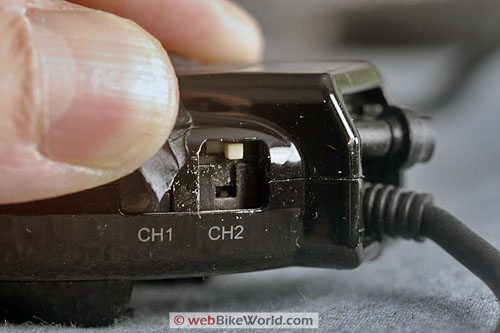
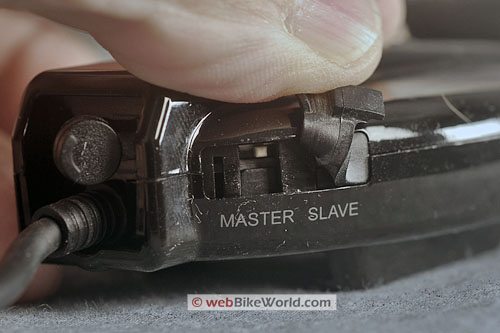
Besides trying to figure out the instructions, here’s what makes it difficult to get the units paired: they first have to be put in a sort of “waiting for pairing” mode by pressing the “–” (minus) key for 3 seconds, then a tiny dip switch must be uncovered (photo top) and flipped from channel 2 to channel 1 and back again. Somehow, this triggers the pairing between the two units.
How much sense does that make? If the darn things won’t just pair together, why not just put a “Pair” or “Connect” button somewhere on each unit? Maybe hold the buttons down until a light or sound goes off.
Uncovering the little dip switch is a pain, and flipping it is worse — you’ll need a pen point or something with a point, or a fingernail like the kids in the “Children of the Damned”, because it’s very tiny and buried in a hole.
Sorry if we sound sour, but we’re just fed up with the inscrutable instructions and nerdy methods used on these electronic things. It’s like they came out of the mad scientist’s electronics lab and never went through a user interface test, probably because they haven’t and the guys who made them are electronics nerds.
Anyway, after the intercoms are paired with each other, they hopefully won’t have to be paired again, but plan on doing the 2-1 channel switch to pair the units with a cell phone or any of the other Bluetooth (Blueteeth?) devices that are supposed to work with the units.
Oh, and by the way, I forgot to mention — to get them paired, one of the intercoms has to be in “Master” mode while the other is in “Slave” mode, which means uncovering and flipping another dip switch (bottom photo above).
UPDATE: We originally thought that only one unit will pair with a Bluetooth-capable cell phone and that unit has to be in “Slave” mode. There is no description of this in the owner’s manual that we could find. However, we have since discovered that the units can be paired in either mode.
Benchmark Helmets also wrote:
“That is incorrect, you can actually have two riders on intercom with one another with each rider having their own cell phone and MP3 player hooked up, listening to different music that will fade in and out as they talk.
The main feature of the stereo headsets is the rich quality of sound. I feel that you weren’t able to take advantage of that leaving a lot of your readers who may be interested in the product for that reason with
no feedback in regards to that. I believe that once you understand the way the unit functions, you can then fully take advantage of the great features the Camos has to offer.”
Since we’re not in favor of talking on a cell phone while riding a motorcycle anyway, this wasn’t a problem for us anyway. We don’t have a Bluetooth GPS or a Bluetooth music player handy, so we weren’t able to try to pair the units with those products.
During various bench evaluations, we were able to get our “Slave” unit to accept cell phone calls and we found that the volume and clarity are excellent. The IMC Camos BHS-600 Bluetooth Intercom system is designed to dial out via the voice function on a cell phone, if so equipped; however, we could not get ours to work (an original Motorola Razr).
To recap: we paired the units with each other as intercoms and they work fine, with good, loud stereo sound. We paired each unit in “Slave” mode with a Bluetooth (Motorola Razr) cell phone and each worked with no problems receiving calls, but we could not get the system to link with the Razr’s nice voice calling activation mode to dial out, a minor inconvenience that we don’t miss at all.
We did not pair the units with a Bluetooth GPS unit or Bluetooth music player because we don’t have access to these types of devices, so we’ll have to assume they will pair and that the voice quality would be as good as the intercom and phone pairings.
As we understand it — although we don’t think this is fully explained in the owner’s manual — the idea of the Bluetooth 2.0 and the dual channels is that the user can pair with another IMC Camos unit as an intercom and a Bluetooth-capable music device or a Bluetooth-capable GPS simultaneously. This type of multiple simultaneous use is apparently new to Bluetooth devices and wireless motorcycle intercoms, and some riders require these capabilities.
The Camos intercom units have 3 buttons (photo above), which are very hard to find when wearing motorcycle gloves. Once the units are turned on by pressing and holding the “–” (minus) key, the “+” and “–” keys are used to raise or lower the volume, although we always keep the volume on high. The unit signals that the volume is as high as it will go with a slight tone.
The third button is a “T” shape, used for cell phone calling and receiving and to activate or hang up a call.
All told, despite our griping about the user interface, once the IMC Camos BHS-600 Bluetooth Intercom is up and running, works very nicely indeed. It’s loud and the dual speakers help greatly in distinguishing voice and understanding the conversation.
We tried both mikes but settled on the boom mikes because they can be positioned closer to the wearer’s mouth. The mikes seem directional; that is, one side works better than the other, so play with it first to determine which side works best before installing it.
The wired mike can be attached via its Velcro patch to the back of the chin bar of a full-face helmet, and it will work, but we found that if it’s more than an inch or so from the mouth, it doesn’t pick up sound as well and degrades the performance of the system.
Two things have surprised us: one is that, in our system at least, there is always some background static and hum that can be heard when ambient noise is low. The Interphone system is completely silent in the background, so we’re not sure what causes the Camos system to have static. It’s not that noticeable, but it’s there. It could be something to do with the very sensitive microphones, which, by the way, are supposed to incorporate some type of noise cancellation.
The other surprise is that the two paired intercoms have only about a 20 foot (claimed 10 meter) range. This is much less than the 150 meter or so Interphone range — I can clearly hear my riding partner on the Interphone when I’m down in the driveway and she’s up in the house, but get about 20 feet apart with the Camos system and you’ll get a rash of static and then nothing.
The systems re-connect fairly quickly when brought back within range, but realize that the Camos units are meant only for use as rider-to-pillion intercoms and not for bike-to-bike.
Also, the range seems to be dependent on the placement of the intercom units. If they’re not pointing directly at each other, or if one is mounted on the back of a helmet and one towards the front, the range decreases.
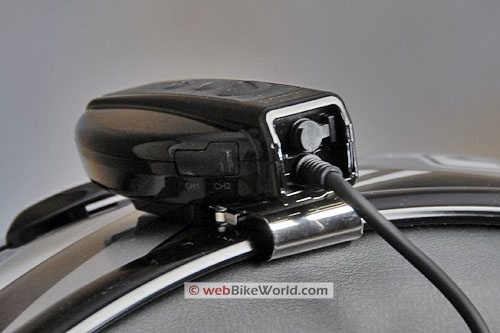
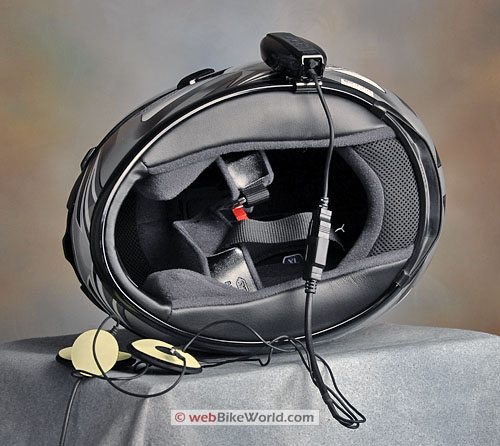
Which brings us to the last issue: the mounting clips. The Interphone has a nice, hefty clip with screws that can be attached to the side of the helmet. The Interphone unit also mounts horizontally, which we think is the preferred method.
The IMC Camos unit is mounted vertically, which is more difficult to do on a helmet. Also, the clip for the IMC Camos is a cheap-feeling pressed metal spring clip without screws, and we can’t get it to securely fasten to any of the helmets we’ve tried. It just doesn’t grab the helmet and it flops around quite a bit and doesn’t give a feeling of security.
The intercom does come with a second clip that has double-sided stickum on the back. The book shows the preferred mounting location for this clip on the rear of the helmet, which is probably the best place to put a vertically-mounted unit, but which then means that it’s very hard to use the intercom buttons while riding. The bottom line is that the IMC Camos BHS-600 mounting system leaves a lot to be desired, in our opinion.
What else? For the technically minded, the IMC Camos BHS-600 Bluetooth Intercom supports the A2DP (Hi-Fi-Stereo) and HSE (Hands-Free) protocols. The and connector of the Bluetooth module are waterproof.
And in case you’re wondering, we did try to pair the IMC Camos units with the Interphone and Scala units but could not. Again, the promise of Bluetooth was that it would recognize and pair with any other Bluetooth device.
You’d think two supposedly simple Bluetooth intercoms would pair with each other? Nope. We’re not sure if these systems are using proprietary implementations of the Bluetooth standard, which, it would seem, goes against the purpose of the communications protocol.
Conclusion
The IMC Camos BHS-600 Bluetooth intercom, after all is said and done, is about as easy to set up as the Interphone intercom — but that isn’t saying much. These devices could and should be so much easier to use, and the instructions on all of the Bluetooth intercoms we’ve reviewed could be better.
Also, the helmet mounting system is very poor, in our opinion, and not up to the standards of the unit itself or the Interphone or Scala Bluetooth intercom systems.
Once the IMC Camos system set up and installed, however, the sound quality and volume make up for a lot. Not that it couldn’t be better; even more volume would be appreciated; a mike that could be located on the back of the chin bar with no loss in sensitivity; less background crackling and static and a better range would be nice.
We like the Interphone system for its ease of use, it’s compact size and it’s long range intercom ability. But it is missing a second speaker, and the sound volume could be higher.
We think the IMC Camos system, in the end, is a step forward in motorcycle Bluetooth intercom systems. It’s not perfect by any means, but at least motorcycle Bluetooth intercom systems are evolving in the right direction.
UPDATE: October 10, 2007 – After using the IMC Camos intercom for a few weeks, we started to have a problem with one of the units. It no longer receives the transmission from the second unit; the static has increased dramatically; it has a great deal of feedback and, believe it or not, it also receives occasional commercial radio interference! Garbled sounds from local radio stations can be heard, blocking out other communications.
At this point, we’ve tried to reset the devices with no luck, so the system is inoperable. We’ve received no response from the manufacturer regarding this problem. We may have an early production model or there may be other problems, but if we learn more, we’ll let you know.
UPDATE 2: October 23, 2007 – see comments from IMC below.
Owner Comments and Feedback
See details on submitting comments.
From “J.H.”: “After reading the reviews on headsets I decided to go with the Camos since hearing isn’t one of my better traits. Ask my wife she will concur. It was fairly easy to pair with my HCT Tilt phone that uses the Bluetooth 2.O technology.
The problem came when I tried to pair it with my TomTom Rider (review). The Rider found the Camos but could not connect. I keep getting an error message stating “the required functions could not be found”.
At this point I will have to do some soul searching as I really wanted to hear directions plus use the MP3 on the TomTom Rider. The sound on the unit is great for the phone even up to 70. It seems to answer automatically instead of waiting for a voice command. The phone rang while driving down the road and next thing I know the wife is talking. However, she heard me clearly even running 7k RPMs on the bike. Bottom line if you have a TomTom Rider that you want to use with a headset, this is not the unit to use.”
From “K.D.”: “I am a computer person who rides. First things first: To get the passenger to also hear the music being played by the Zumo, C.H. (comments below) would need to get another Bluetooth adapter (like a wiRevo D1000V ) and connect it to the (standard) audio out headphone jack on the Zumo and then pair that to the passenger’s Camos.
As you have learned in your adventures in Bluetooth land things have to be done in the right order or it will not work as expected. If you have the Zumo 550 the rider should pair his cell phone to it and NEVER the Camos or he will run into some of the problems B.A. had.
The next step would be to pair the Zumo’s built-in Bluetooth to the Rider’s Camos. The passenger would then pair her cell phone to (the passenger’s) Camos, then pair the external Bluetooth adapter (Revo) on the headphone jack of the Zumo to (the passenger’s) Camos. Then do the intercom pairing as per the manufacturer’s lack of instructions.
On a related note: Thanks to a very small patch of gravel I need a new helmet. While the bike and myself have been healing up I have done a lot of research (thanks BTW I found your site to be most informative) concerning motorcycle audio distribution and quiet helmets.
Once a week I have a 3 hour commute to work (6 hr round trip), in order to make my bike a practical choice I need to be able to hold reasonably clear cell phone conversations with my co-workers and customers. Also I seem to have become addicted to GPS so I figured I wanted to come up with a complete solution.
From reading reviews and understanding the base technology, with the exception of connecting the cell phone to the Zumo, I’m going to pass on Bluetooth for the bike. First off, I have never heard a decent sounding pair of stereo Bluetooth headphones (for home, let alone a motorcycle), they seem to always have a background hiss.
Besides, what is the benefit in going wireless when you are sitting in the same place and I don’t want another device to forget to put on a charger? I am several clicks away from getting a Garmin Zumo 550, a Baehr BLACKLINE Active System and a SCHUBERTH J1 helmet, hopefully it works out…”
From “B.A.” on the wiRevo: “I have recently purchased the Camos and another Bluetooth accessory called a wiRevo. The wiRevo is supposed to make the Zumo or other non-stereo Bluetooth items stereo. I felt that I may be able to help or at least air some (issues) I had and my encounter in the future with the Camos.
I purchased the system this week and after not getting much help from benchmarkhelmets with my problem I called the place of purchase, The Scooter Shop in California. They said that they would get back to me but they haven’t. Maybe I’m too impatient.
Here is what has transpired this week. I receive the items and wanted to pair them with a Zumo. I followed the instructions that were being talked about in K-bikes and BMW Luxury Touring Forums. I have been talking with the fellows pretty often for the past few weeks and thought I would pull the trigger on these items.
On Tuesday I was trying to get the items to pair all day. I thought I had it all paired properly but some systems really don’t let you know very well if they are. Flashing lights and what have you. I like the phones and Zumos that tell you when they are paired.
That evening I tried it all out and went for a ride. Possibly and I don’t know this but maybe the Zumo has to be in the cradle to work properly, and maybe that is why I couldn’t get the systems to work together.
Well, after getting it all working together I thought I did take a ride. The first thing was to have the Zumo talk to the Camos and let it give me directions. That went pretty well, then I thought I should try the MP3 player in the Zumo to see if I can hear music.
That also went well. As I was riding I was listening to music and the Zumo cut in to tell me that I needed to make a turn. That went alright also. I’m pretty psyched at this point.
All of a sudden the phone rings. (Moto Razr Max, top of the line Moto right?) I answer the call and I can hear the other person but they can not hear me. Bummer; I go home and work on this for 4 more hours and can’t get it to work properly.
Wednesday, I call and call benchmarkhelmets and no one answers all day or night. I call The Scooter Shop and I speak to a fellow and he tells me that he’s no expert and he’ll have someone call me later.
Wednesday mind you, Thursday I call benchmarkhelmets and no one answers again but I did get a short email saying that I should have the Zumo on (phone only in the Bluetooth directory). I did have it there and I responded to them telling him that. No reply. Still no one from the Scooter Store has called or answered my emails.
Sorry guys, I would like to know how to use my $300.00 worth of items I purchased from you. So I start all over again and try to pair these but without the Zumo on the cradle just doing this on my lunch hour and trying to get things to work properly. I got the phone to make calls but no music.
Friday, I didn’t have a chance on Thursday evening to fool around with the system so I thought I would send off some more emails to the both of them and no response as of 4 pm Friday.
I went home from work and tried it all again. Here is what transpired on Friday afternoon:
I got the Camos to talk to the phone so I thought that would be good. I got the Zumo to talk to the Camos, that was good. I then called my wife at work and told her that I would be calling her back to test this all out again and if she gets a call and can’t hear someone on the other end that it was me and don’t hang up immediately, give me a chance to talk.
I called with the Zumo off and the Camos did fine.
I hung up and turned on the Zumo and it said that it made the connection. Now the Zumo and the Camos are talking to one another. It is giving me directions and playing music and cutting in and out at the appropriate times. This is good. Now I tried to have the Zumo on and make a call, this didn’t work. I couldn’t figure out what was wrong.
So I went into the directory and changed the settings that benchmarkhelmets told me to set (Phone Only). I change it to Navigation, MP3, Phone, it started to work. I could hear the Zumo, I could hear the phone now.
So I called her again and she could hear me and I could hear her. This was all fine and good until I realized that I couldn’t change the volume. And the volume was too low, not quiet but not loud enough if I were riding with ear plugs that’s for sure.
Now here’s the good part — I then thought ok, let’s try to hook up the wiRevo and see if the whole thing goes to S_ _ t. And it did. When I plugged in the wiRevo to the Zumo which were paired earlier the sound and everything went quiet.
Then all of sudden the music came on and it was loud and in stereo. I guess it need to connect to the Zumo. So I tried to make the Zumo give me directions and it did. I then picked up the phone and called my wife and it worked fine she said.
So now everything is working as of the time I left my house a few hours ago. I just hope this continues. Oh by way, I did say it was loud but I now have control over the volume. The wiRevo made a big difference with control and fidelity. I did have the bike up to about 80 mph with ear plugs in and it still was fine to hear. That was the other night the first time I was putting it together.
I do want to tell you this; I’m not convinced that it will keep working properly because from the messages on two forums the fellows from benchmarkhelmets say that the Zumo has to be on (phone only) I have it on NAV, MP3, phone.
But it’s working. Another thing that tells me that it’s not going to continue is that in the manual the chart tell you that if the red light is flashing 3 times in a second or two that the connection failed and mine is flashing in series of 3s.
Would the fellows from IMC please respond and give us some detail to the trouble shooting? Also; what does it mean when the green and red light flash at the same time?
I was going to take notes because I wanted to explain everything in detail so others could benefit but I was too happy to get it working.
In review, I think the Camos is very good as far as sound quality. I don’t mind the small switches. The Camos also goes into pairing mode real easy when you want it to and that’s good.
The wiRevo on the other hand is tough as hell to get in the pairing mode and is a bear to coordinate when trying to pair because it only gives you I think one minute and then goes back to normal. wiRevo company needs better instructions.
WiRevo when it gets paired is unbelievable; it makes the Zumo come alive when used with the Camos. Personally a tad more volume and a way to adjust the bass a bit would be ok but believe me this works with decently good fidelity.
Benchmarkhelmets and The Scooter Shop I will apologize to you if I’m being impatient and not giving you a chance to respond. But I think a week is a long time when you are trying like hell to get this system up and running with out any assistance.
I am the first to say that I’m not the tech minded person that some are but a good manual and a trouble shooting segment in the manual would really help.
IMC, I think your going in the right direction and I like the products. Just give us consumers some help. Attention to the companies mentioned here, people like myself are your best sales staff. I visit 3 motorcycle forums each day and participate in them pretty good. I know this stuff is new but we can help but we also want your help.
Thanks for letting me ramble on I hope I have been of some help.”
Benchmark Helmets Response: “We just wanted to make a statement about us being out of action, we were in Milano, for EICMA, and basically only had a skeleton staff here shipping orders to our dealers. We tried to direct people toward sending emails, however it is hard to do so without having access to talking people on the phone.
As far as technical knowledge not everyone at Scooter Shop knows all about GPS systems and such, other dealers such as Wireless Riders have a stronger technical knowledge of getting working in harmony (since they sell the Zumo).
The beauty of Bluetooth 2.0 is that once everything is dialed in, you shouldn’t experience any problems with having to repair your devices very often. I agree that the setup of the Camos system is more technically challenging than the other Bluetooth helmet headsets, however the superior sound quality is worth the extra effort. If (customers have) any more questions (they) can call us at 1-866-622-0221.”
Response from IMC regarding our problems: “Thank you very much for your testing report, which – as you may assume – does not please us. Nevertheless we would like to let you know our impression and give you some more background information and facts.
1. Static noise – We hold the official FCC documents that declare strict compliance to the regulations. We have now 8 months field experience in Germany, Europe and the United States. Since your couple of BHS-600s seems to be the only one that can receive commercial radio, we suggest to contact our US partner Benchmark Helmets to receive another set. In consequence we think that your headsets have not been fully charged. Please re-check after charging over night.
2. Bluetooth
Bluetooth is able to establish connections without user action, once the pairing is done. Pairing is needed to avoid any coupling by random. Pairing cannot be done automatically, because to pair BT-devices they must be set into special listen/search mode. Otherwise you will get a wild mix of connections. It works like the key and lock principle, in IT slang: master and slave. So both devices must match to get a secure connection.
We sell BHS-600 separately. So all units are set to single mode by default. If you buy two, you must change the settings. This is not complicated – we guess even less complicated than setting up a mobile phone. We understand that we cannot assume bikers to be computing specialists, but they learned driving and have a huge knowledge about bikes, they should be able to handle a small electronic unit. If not, they should buy the units from a specialized dealer who can install and instruct the units.
Ah, one word about compatibility: Bluetooth and Bluetooth aren’t same. You know that there are various Bluetooth standards from 1.0 to 2.0, 3.0 is under development. And, to use IT-slang again, the manufacturers optimize the so-called Bluetooth stack, which provides the relative functions like A2DP (stereo music), HFP (hands free), etc.
To get better results, it is recommended to skip all un-used protocols from the stack. That might be one reason for “incompatibility”.
3. Manual
We are very sorry having not found a real native US-biker to translate a technical manual for us. Next time we will take care of it. We have not added general Bluetooth information, because we did not see any requirements. If our dealers confirm your statement, we will add in future. In the meantime, please check Wikipedia.
4. Reset
Maybe the devices went down due to low battery status or due to production failure. We cannot evaluate from here. Please let’s exchange the set so we can check them in our labs.”
From “C.H.”: “I recently purchased a Garmin Zumo 550 and 2 Camos BHS-600 intercom units for my wife and I to use when riding. I am very happy with the Zumo, and the sound quality of the BHS-600s for music, phone and intercom communication is very good. But I was hoping to be able to pair both units to the Zumo so that wifey and I could listen to the same music on long trips. So far I haven’t found a way to do that.
Garmin tech support states that the Zumo can only pair with one unit at a time, and a very helpful Camos guy in Canada stated that he did not know of any trick to accomplish this on the BHS-600 side.
Do you or any of your readers know how this might be done? Perhaps an additional unit that pairs with all three? This is going to be a disappointment if it can’t be done – it just seems like such functionality would be desired by anyone buying either device.”
Editor’s Note: Please send any tips on this issue to the email address above.
From “B.”: “One thing you didn’t mention is the size of the Firewire connector (Editor’s Note: See photo below) that connects the speakers and mic to the Camos unit. Why did they use this? The connector is HUGE and I found that there is no place to hide it on my helmet. It is too big. Also, they give you too much wire for all the parts, I have to stuff the wire all over the inside of my helmet. Right now I have the Firewire connector hanging outside my helmet, this is a problem.”
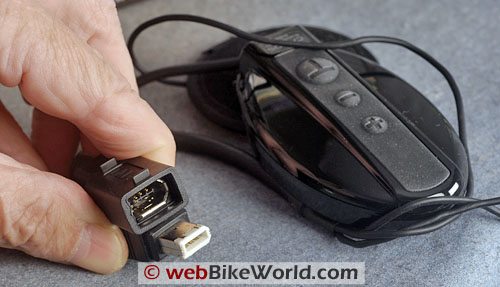
Other WebBikeWorld Intercom Posts


